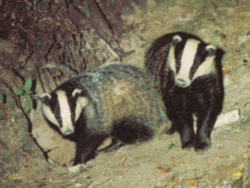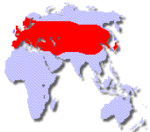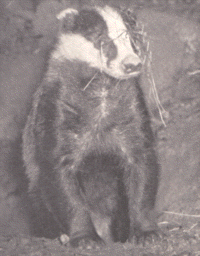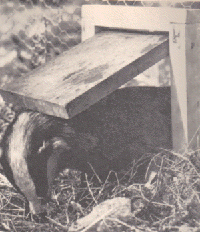 SKC Films Library SKC Films Library |
| SKC Films Library >> Science >> Zoology >> Mammals >> Order Carnivora >> Family Mustelidae |
| Eurasian Badger Meles meles [mel' Ez mel' Ez] Description This badger has a stocky 3-foot-long body, short tail and short but powerful legs armed with strong claws on the front feet. Average weight is 22 to 35 pounds, with males being only slightly larger and heavier than females. The coloration is grayish on the body, being darker gray to almost black on the legs. It is distinguished from other badgers by the markings on its head -- the majority of the face is white, with two black stripes, one on each side of the head, running laterally across the face, from the nose, over the eyes, to the base of the ears (the American badger, by contrast, has a dark-colored face with a single white stripe).
Distribution and Habitat The Eurasian badger is found throughout Europe and Asia, as far north as Norway and Sweden, as far east as Japan, and as far south as southern China. It prefers densely forested areas adjacent to areas of wide open fields, but will live almost anywhere, including coastal habitats and even urban areas.
Diet Badgers are opportunistic and omnivorous feeders. They dine on a wide variety of invertebrates (earthworms, insects, mollusks, beetle and wasp larvae), rodents, ground-nesting birds, small reptiles, frogs, and carrion. Vegetable foods include acorns, nuts, berries, fruits, seeds, cereal grains, tubers, roots, bulbs, and mushrooms. Social Behavior European badgers live in clans of up to 20 or so individuals, with clans being larger and more closely knit in colder climates. All the badgers in a clan are closely related. The clan is lead by a dominant pair, a male and a female, and the rest of the clan is their offspring. The dominant male may mate with several of the females in the clan, but if a subordinate female's pregnancy is carried to term the dominant female will track down and kill her cubs. Clans live in large underground catacombs called setts. Usually constructed in wooded areas, these are interlocking tunnels which contain the nesting and sleeping chambers, and often have a dozen or more entrances and exits to the surface. Setts are inherited from parents, and can be centuries old. Badgers are very meticulously clean animals, and the setts are kept immaculate. Bedding material, which is comprised of dried grass, moss and leaves, is changed frequently. a badger bringing new bedding
material to the sett Clans maintain home ranges of 50 to 150 hectares, with little to no overlap between clans. Eurasian badgers are very territorial and will defend their home ranges from other badgers. Borders are scent marked and patrolled by the dominant male. Individual badgers have ranges within the clan's territory, and border fights do occasionally occur. Reproduction Mating takes place in July or August but the embryos do not begin to develop until December or January. Gestation lasts for seven weeks after implantation, and one to five young are born during February or March. Newborn cubs are about 4-5 inches in length. Their eyes and ears open at five weeks, their teeth erupt at about six weeks, and they are weaned at about six months. For the first six to eight weeks of their life they stay underground, then make their first, tentative visits to the outside world. They will leave their birth setts for good in October or November, and reach sexual maturity at about 12 to 15 months of age. Parental care is provided entirely by the mother. Other Information Badgers are almost exclusively nocturnal, coming out in daylight only on very rare occasions. Signs of the badgers' presence are unmistakable. They have regular, well-trodden paths leading from the sett which may be followed for some distance, often running to a stream or pond where they habitually drink. Because of this habit small gates can be built in wire fences, constructed to keep out rabbits and other pests from farmlands and forests but allowing the beneficial badgers (who prey on those pests) to come and go as they wish. a badger gate Adult badgers have little to fear from predators. If cornered, they are very tenacious, and are capable of inflicting serious damage with their powerful jaws and sharp claws. Scientific Classification phylum Chordata SEE ALSO |
| SKC Films Library >> Science >> Zoology >> Mammals >> Order Carnivora
>> Family
Mustelidae This page was last updated on June 14, 2017. |



